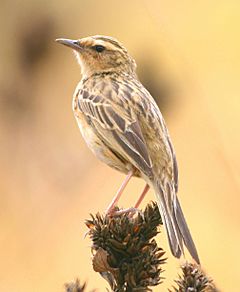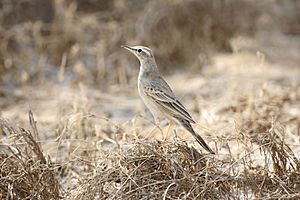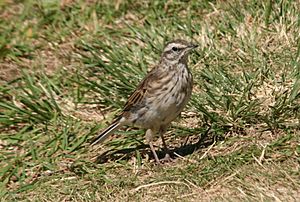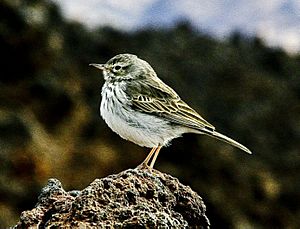Pipit facts for kids
Quick facts for kids Pipits |
|
|---|---|
 |
|
| Nilgiri Pipit | |
| Scientific classification | |
| Kingdom: | |
| Phylum: | |
| Class: | |
| Order: | |
| Family: | |
| Genus: |
Anthus
Bechstein, 1805
|
| Species | |
|
c.40, see text. |
|
Pipits are small birds found almost everywhere in the world. They have medium to long tails. These birds belong to a group called Anthus. They are part of the Motacillidae family, which also includes wagtails and longclaws. You can find pipits in most places, but not in very dry deserts, thick rainforests, or Antarctica.
Pipits are slender birds. They often have dull, brownish colors. They mostly eat insects found on the ground in open areas. Like their relatives, pipits usually have one mate for life. They also defend their own space. Pipits build their nests on the ground. They lay up to six speckled eggs.
Contents
What Pipits Look Like

Pipits generally look quite similar to each other. Most pipits are about 16 to 21 centimeters (6 to 8 inches) long. The smallest species, the short-tailed pipit, is only about 11.5 to 12.5 centimeters (4.5 to 5 inches) long. They weigh between 15 and 38 grams (0.5 to 1.3 ounces).
Like other birds in their family, pipits are slender. They have short necks and long tails. Their legs are long and thin. They also have very long claws on their back toes. The length of this back claw changes depending on where the pipit lives. Birds that spend more time in trees have shorter, more curved claws. Those that stay on the ground have longer ones. Their beaks are usually long, thin, and pointed. Male and female pipits look very much alike.
One special thing about pipits is how their wing feathers are arranged. Their outer feathers (called tertials) completely cover their main flight feathers (primaries). This is thought to protect the important flight feathers from the sun. Sunlight can make feathers fade and become weak.
Feather Colors and Patterns
The feathers of pipits are usually dull brown, buff, or faded white. Their undersides are often darker than their backs. They have different amounts of stripes and streaks on their backs, wings, and chests. These dull, mottled brown colors help them blend in. They can hide easily among the soil and rocks where they live.
A few species have slightly brighter colors when they are ready to breed. For example, the rosy pipit has greenish edges on its wing feathers. The yellow-breasted pipit is unusual. It has bright yellow feathers on its throat, chest, and belly.
Where Pipits Live
Pipits live almost everywhere on Earth. They are the only birds in their family found widely in North and South America. Three species of pipits live in North America. Seven species live in South America. The rest are found across Europe, Asia, Africa, and Australia. Two species live only on islands in the Atlantic Ocean. About six species can be found on more than one continent.
Pipits live in many different types of open areas. They are not found in the driest deserts. They are mostly linked to grasslands, from sea level up to high mountain areas. The rock pipit and South Georgia pipit live among rocks and cliffs by the seashore. Other species live only in high mountain areas for part of the year.
Pipits live in cold northern areas and on subantarctic islands. They also live in warmer tropical regions. They do not live in tropical rainforests. However, some species live in open woodlands. For example, the wood pipit of southern Africa lives in open savanna and miombo woodlands.
Pipit Journeys and Migration
Pipits can either stay in one place their whole lives or travel long distances. Island species, like the Berthelot's pipit (found only on Madeira and the Canary Islands), do not move much. Some species in warmer areas, like the Nilgiri pipit, also stay put.
Other pipits move around a bit during the non-breeding season. This happens with the long-legged pipit in central Africa or the ochre-breasted pipit in South America. These movements depend on the environment and are not always easy to predict.
Many pipit species make longer, regular migrations. They travel between specific breeding grounds and wintering areas. The tree pipit breeds in Europe and northern Asia. It spends winter in Asia and Africa south of the Sahara Desert. This is a common pattern for species from northern areas.
Some species are partly migratory. Northern groups might migrate, while those in milder areas stay put. The meadow pipit in Europe is an example. The distances they travel are not always long. The mountain pipit of southern Africa breeds in the Drakensberg mountains. It only migrates north to Angola and Zambia.
Pipits usually migrate in groups. They can travel both during the day and at night. However, the Sprague's pipit in North America seems to migrate only during the day.
Pipit Behavior and Habits

Pipits are active birds that spend most of their time on the ground. They fly to show off during breeding season. They also fly when migrating, moving to new areas, or when they are scared. A few species use trees. They might perch in trees or fly to them when disturbed. Low bushes, rocks, and termite mounds can also be used as good lookout spots.
Like their relatives, the wagtails, pipits wag their tails. How a pipit wags its tail can help you tell different species apart. For example, upland pipits flick their tails quite fast. Olive-backed pipits wag their tails more gently. Generally, pipits move their tails slowly. The buff-bellied pipit wags its tail both up and down and side to side. We don't know exactly why they wag their tails. For wagtails, it might be a way to show predators that they are alert.
What Pipits Eat
Pipits mainly eat small invertebrates. Insects are the most important food. They eat flies and their larvae, beetles, grasshoppers, crickets, true bugs, mantids, ants, aphids, and especially moth and butterfly larvae and adults. Besides insects, they also eat spiders. Rarely, they might eat worms and scorpions.
What adult pipits eat might be different from what they feed their young. For example, adult tree pipits eat many beetles. But they don't feed many beetles to their chicks. Pipits that live by the seashore are known to eat marine crustaceans and mollusks. A few species have even been seen eating small fish. They beat the fish like a kingfisher would. Rock pipits have also been seen eating fish dropped by puffins. These fish were dropped when gulls bothered the puffins. Some pipit species also eat berries and seeds.
See also
In Spanish: Bisbitas para niños




